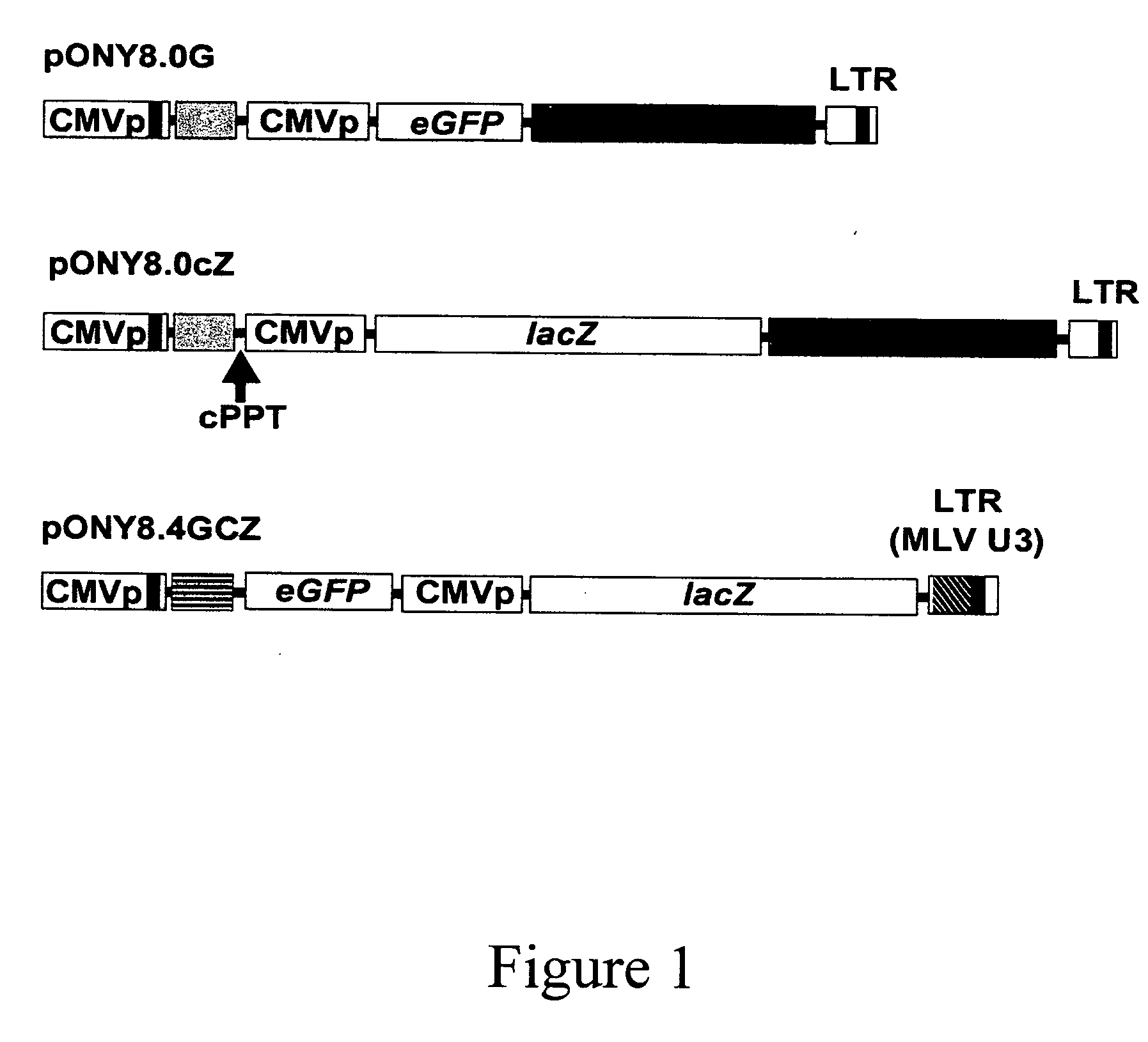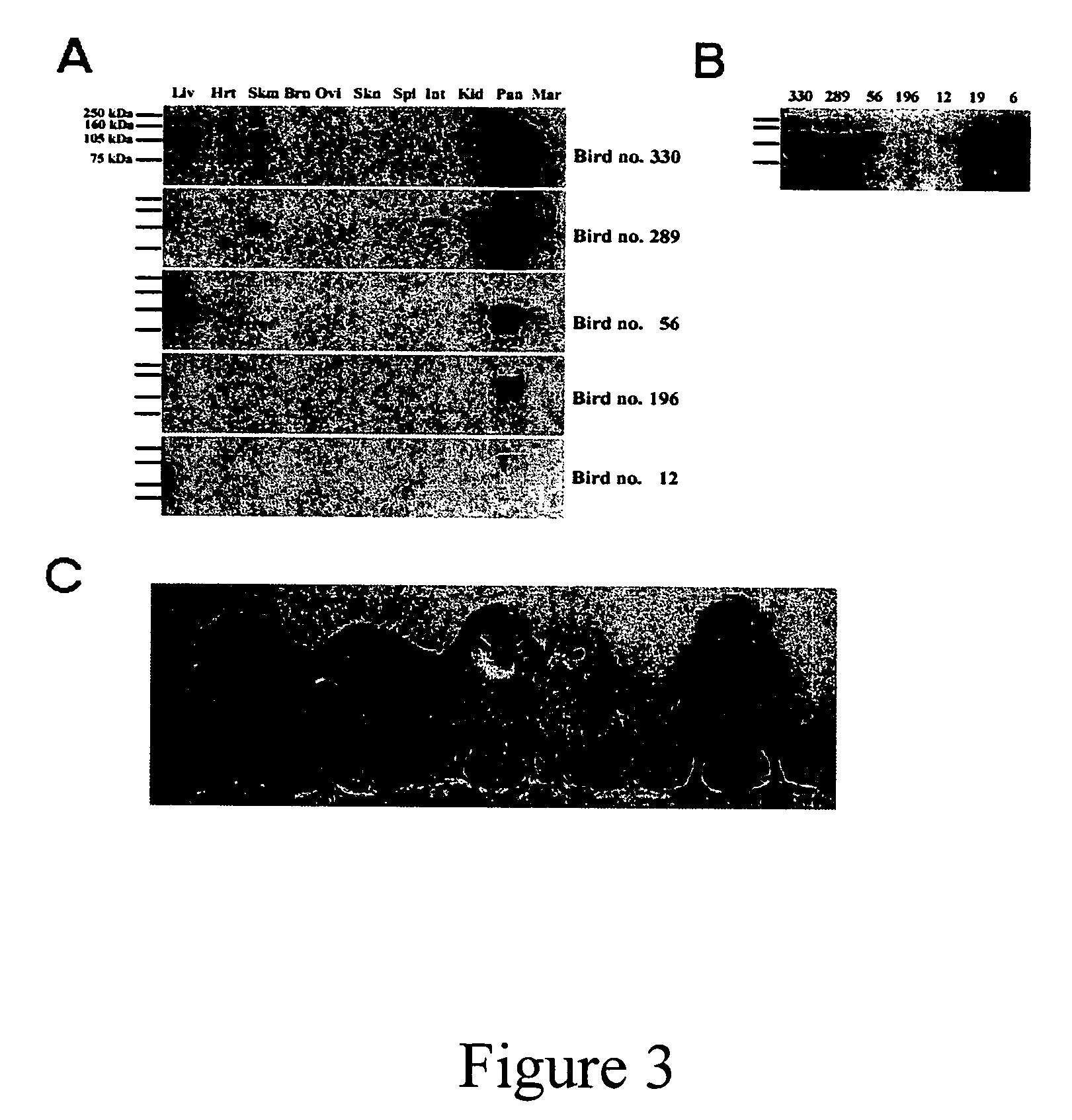Methods for producing transgenic animals with modified disease resistance
a technology of transgenic animals and resistance, which is applied in the direction of genetic material ingredients, antibody medical ingredients, peptide sources, etc., can solve the problems that the economic importance of disease in chicken production (both layers and broilers) is difficult to estimate, and achieves a high level of rna and protein, small and simple
- Summary
- Abstract
- Description
- Claims
- Application Information
AI Technical Summary
Benefits of technology
Problems solved by technology
Method used
Image
Examples
example 1
EIAV Vectors and Preparation of Virus Stocks
[0239] The vectors pONY8.0cZ and pONY8.0G have been described previously (1). The vector pONY8.4GCZ, previously described in WO 03 / 064665, has a number of modifications including alteration of all ATG sequences in the gag-derived region to ATTG, to allow expression of eGFP downstream of the 5′LTR. The 3′ U3 region has been modified to include the Moloney leukaemia virus U3 region. Vector stocks were generated by FuGENE6 (Roche), transfection of human kidney 293T cells plated on 10 cm dishes with 2 μg of vector plasmid, 2 μg of gag / pol plasmid (pONY3.1) and 1 μg of VSV-G plasmid (pRV67) (1). 36-48 hours after transfection supernatantants were filtered (0.22 μm) and stored at −70° C. Concentrated vector preparations were made by initial low speed centrifugation at 6,000 g for 16 hours at 4° C. followed by ultracenrifugation at Xg for 90 minutes at 4° C. The virus was resuspended in formulation buffer for 2-4 hours (1), aliquoted and stored ...
example 2
Production and Analysis of Transgenic Birds
[0240] Approximately 1-2 μl of viral suspension was microinjected into the sub-germinal cavity beneath the blastodermal embryo of new-laid eggs. Embryos were incubated to hatch using phases II and III of the surrogate shell ex vivo culture system (2). DNA was extracted from the CAM of embryos that died in culture at or after more than twelve days of development using Puregene genomic DNA purification kit (Flowgen, Asby de la Zouche, U.K.). Genomic DNA samples were obtained from CAM of chicks at hatch, blood samples from older birds and semen from mature cockerels. PCR analysis was carried out on 50 ng DNA samples for the presence of proviral sequence. To estimate copy number control PCR reactions were carried out in parallel on 50 ng aliquots of chicken genomic DNA with vector plasmid DNA added in quantities equivalent to that of a single copy gene (1×), a 10-fold dilution (0.1×) and a 100-fold dilution (0.01×) as described previously (3)....
example 3
Production of Founder Transgenic Birds and Germline Transmission
[0241] Three different EIAV vectors (FIG. 1) were used and packaged virus produced pseudotyped with vesicular stomatitis virus glyco-protein (VSV-G). These vectors have been used to transducer a number of tissues, both in vitro and in vivo (1,4-6). The vector preparations were concentrated to give titres of approximately 108 to 109 transducing units per millilitre (T.U. / ml). One to two microlitres of concentrated virus was injected into the subgerminal cavity below the developing embryonic disc of new-laid eggs, which were then cultured to hatch. Genomic DNA was extracted from chorioallantoic membrane (CAM) of any chicks that survived past the midpoint of incubation (10 days), including hatched chicks, and analysed by PCR to detect specific vector sequences (embryos injected with pONY8.0cZ and pONY8.4ZCG only, Table 1). The PCR analysis was used to estimate the copy number of the vector sequence with respect to the amo...
PUM
| Property | Measurement | Unit |
|---|---|---|
| resistance | aaaaa | aaaaa |
| disease resistance | aaaaa | aaaaa |
| polymorphic | aaaaa | aaaaa |
Abstract
Description
Claims
Application Information
 Login to View More
Login to View More - R&D
- Intellectual Property
- Life Sciences
- Materials
- Tech Scout
- Unparalleled Data Quality
- Higher Quality Content
- 60% Fewer Hallucinations
Browse by: Latest US Patents, China's latest patents, Technical Efficacy Thesaurus, Application Domain, Technology Topic, Popular Technical Reports.
© 2025 PatSnap. All rights reserved.Legal|Privacy policy|Modern Slavery Act Transparency Statement|Sitemap|About US| Contact US: help@patsnap.com



